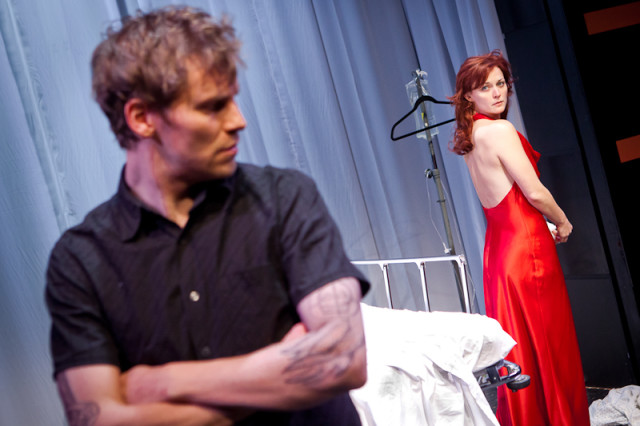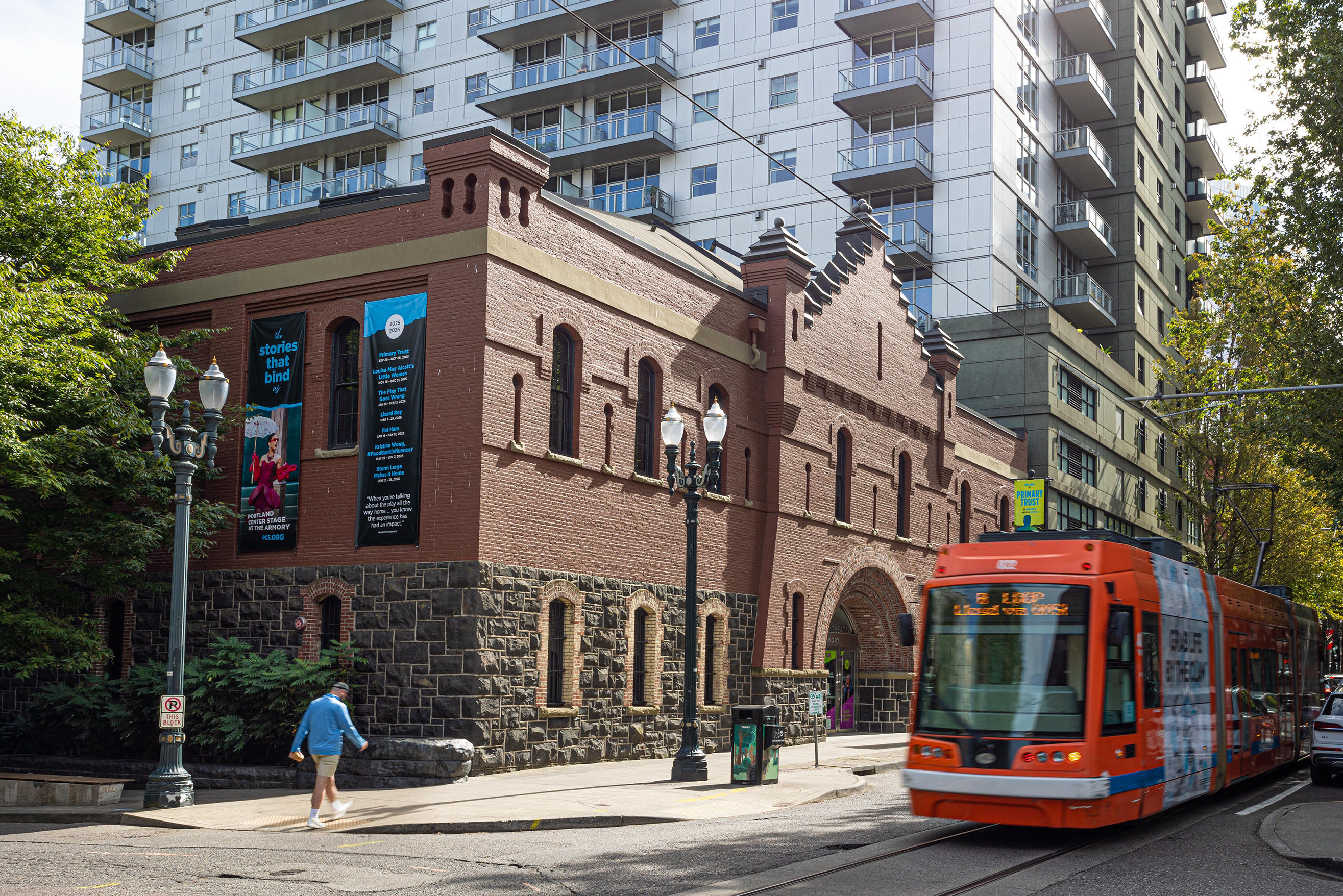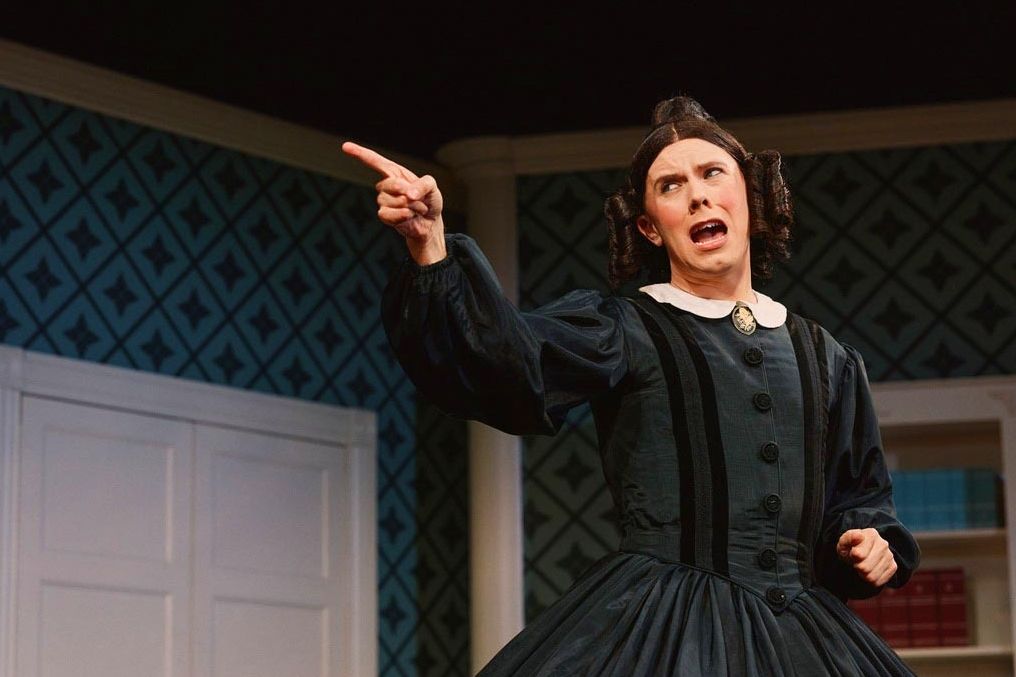Review: (I Am Still) the Duchess of Malfi

Photo credit: Owen Carey
Artists Repertory Theatre’s contemporary re-imagining of the Jacobean revenge tragedy The Duchess of Malfi, re-titled (I Am Still) The Duchess of Malfi, begins with the portly Cardinal (Todd Van Voris) standing in a spotlight, back to the audience, bloodstains bleeding through his shirt from self-flagellation. Three men in black robes and masks dress him in red and white vestments as Carmina Burana-style choral music bombards the audience. A full-blown gothic tragedy is in order, it seems, until the Cardinal snaps his finger and demands of his manservants, “cell phone.”
So former-Portlander Joseph Fisher’s script quickly unfolds, injecting a biting modern wit into the macabre story of the Duchess. And if you’ve a stomach for violence and a taste for psychological thrillers laced with sardonic humor (i.e. you dig Quentin Tarantino), you’ll likely find it a sexy contemporary makeover of the 400-year-old revenge tragedy.
The Plot
Fisher reduces the characters from John Webster’s 1623 classic to the essentials: the Cardinal and his crazy brother, Ferdinand (Jake Street), their sister the Duchess (Sara Catherine Wheatley), her bodyguard Antonio (Vin Shambry), her handmaid Cariola (Camille Cettina), and the mercenary soldier, Daniel de Bosola (Chris Murray). The main difference is Delio, originally a shell of a character who functions as a sounding board for other characters’ exposition, is now a gay gossip of a narrator who steps in an out of the action, addressing the audience like he’s our tour guide to the juicy, twisted, royal scene of Amalfi.
The first act proceeds with a clip, establishing Amalfi as a modern-day, church-run, European city-state, if it were filtered through the celebrity gossip site TMZ. The Duchess, played with a red carpet strut by Wheatley, is just finishing the mourning period for her deceased husband, the Duke. Her brothers, who need her beloved Princess Di-like status to distract the common folk from their cruel rule, demand that she remain a chaste widow for the rest of her life and assign Antonio to watch her day and night. The Duchess sweetly obliges, but as soon as they depart, she tells Antonio she has seen him watching her and insists that they marry in secret, pulling dress and suit from her Gucci shopping bags. Suspecting she might have something up her sleeveless gown, her brothers command Bosola, played by Murray with a manic cockiness reminiscent of a young Christian Slater, to pose as her stable boy in order to spy on her. The act climaxes in a somewhat over the top, yet well choreographed, fistfight between Bosola and Antonio at an Amalfi disco set to Britney Spear’s “Til the World Ends.”
I left for intermission feeling that most of the characters were rather one-dimensional and predictable: the cold, arrogant Cardinal, the spoiled Duchess, the stalwart bodyguard. And although Fisher’s script is funny and the physical humor well directed by Jon Kretzu, comedy so saturated this adaptation that I wondered how or even if we were going to descend into the dark, violent tragedy of the original, where Bosola ultimately strangles the Duchess and her children, and then in an act of unexplained and somewhat unbelievable remorse, goes on to kill the Cardinal, an equally unbelievably remorseful Ferdinand, and, accidentally, Antonio. Press materials for Artists Rep’s world premiere had said the new Duchess “defies her brother’s chess game of power, manipulation and morality.” Perhaps, I thought, this version wouldn’t end in tragedy then, but with the Duchess prevailing.
Suffice it to say my hesitation was premature. The first half was but the Entertainment Tonight pre-show.
The second half opens with the Duchess restrained in a hospital bed, a prisoner of Bosola. Having discovered her relationship with Antonio, the Cardinal instructs Bosola to torture her until she renounces her title, so that the people will hate her and he can appoint a new duchess. But whereas Britney might have been all too quick to shave her head and abdicate her celebrity throne, the Duchess refuses. As Bosola and the Duchess pitch into a battle of wits, will, charm, and insults, the play evolves from Real Housewives of Amalfi into an intense psychological thriller.
A Re-Imagining
The influential English critic Kennath Tynan echoed several centuries of forebears by condemning Webster’s original for “the irredeemable mediocrity of its dramatic evolution of human passion,” which is the stuffy way of saying that the characters go to childishly absurd levels of violence and experience ludicrous changes of heart. But in Fisher’s snappy yet drawn out dialogue in the torture scenes, first of the Duchess and later of Antonio by Ferdinand, he instills motivation into the characters’ stories, giving weight and depth to figures that seemed rather flat in the first act (and certainly in the original tragedy). Wheatley’s increasingly gripping performance as the Duchess in particular goes from a sweeter play on Paris Hilton to the prideful gravitas of a noblewoman, as she recounts her marriage at age 13 to the Duke as being “handed over like a kitchen appliance and used as one.” It was her endurance of his groping and abusive hands that earned her title, and we believe her when she refuses to relinquish it, insisting, “I am still the Duchess of Malfi.” Murray’s unhinged yet charming Bosola also reveals secrets, pulled out by the steel-willed Duchess (“You’re an appliance like me, just a different brand”), that justify his ultimate change of heart.
As the action grows violent, and it gets very very violent, the script’s humor comes to serve a new Brechtian purpose, allowing us to watch the horror unfold without being consumed. It’s one thing to see someone tortured on TV; it’s another to watch it live 10 feet in front of you. But the show draws on modern references, from Shepard Fairey to Occupy Amalfi, as well as fine comic timing on the part of the actors, to incite laughter that manages simultaneously to round off the edges of the violence while also polishing the play’s meditation of power, status, and our need for idols—in today’s case a celebrity kind that has replaced the religious and royal ones of yore.
That said, not all the modern injections stitch up so nicely. Delio as swishy gay narrator, played with finger wiggles and ‘darlings’ by Nicholas Hongola, seems written for an audience that still finds The Birdcage edgy. His constant interruptions in the first act, while garnering many a laugh, weaken the play’s flow. In part, it’s his appearance mainly as a character and not as interrupting narrator in the second half—where he too is fleshed out with newfound ambiguity—that allows the psychological tension to simmer and boil. But he returns at the end for a final address to the audience, and while some closing words might be necessary, his nice moral conclusion and stage equivalent of walking off into the sunset wraps up this meat grinder of a tragedy in too clean of a bow.
We might be overly nice in Portland, but that needn’t mean we can’t handle some good new-fashioned tragedy every now and then.
For more about Portland arts events, visit PoMo’s Arts & Entertainment Calendar, stream content with an RSS feed, or sign up for our weekly On The Town Newsletter!




